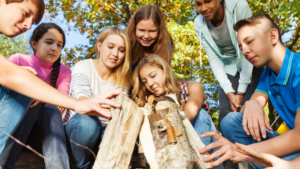The Montessori method is an educational approach developed by Maria Montessori. It is a child-centered approach in which the teacher acts as a “guide” for the children’s self-directed learning.
As we move forward, we will explore the role of Montessori guides in today’s society and how they may benefit children.
In Montessori, the Montessori guide is the equivalent of the traditional teacher: the person who oversees the prepared environment. Their primary responsibility is to facilitate a child’s natural development and facilitate learning. Let us understand it:
Why are teachers called guides in Montessori schools?
A Montessori guide is a person who helps children in the Montessori classroom. This person is not a teacher or a parent and does not have any specific qualifications, but they are trained by the organization to provide support to children in the classroom.
Unlike a teacher, a Montessori guide focuses on observing children within their environment. They observe children’s activities and provide them with the materials that best match their stage of development, rather than teaching them. A Montessori guide helps the child discover their true talents and potential.
The Montessori guide provides a sense of comfort and security to the child. The guide is there to teach the child how to behave in a social setting.
The role of the Montessori guide is to provide support and encouragement for the child. The role of the guide is not to enforce discipline or punishment on a child, but to help them learn about themselves and others.
Montessori guides serve as a link between the material and the child by facilitating and guiding learning by exhibiting and demonstrating the material and how it is used.
What are the skills required for a Montessori guide?
Montessori guides are the backbone of Montessori education. They work closely with the children and help them understand the concepts using the materials in the classroom.
A Montessori guide should be able to:
- Create a safe, nurturing environment for children.
- Demonstrate materials with patience and enthusiasm.
- Engage in conversation with children to help them understand concepts.
- Use observation and discussion to develop a plan of action for each child.
How to become a successful Montessori guide?
The intrinsic qualities that make a successful Montessori guide are empathy, patience, and an understanding of child development.
-
Setting up the Learning Environment
One of the important roles of a Montessori guide is to ensure that a classroom is well prepared and learning materials are accessible to children at all times.
Montessori materials are sequential and interrelated, thus making sure that they provide the right learning materials at the right time.
A Montessori guide ensures child-led learning. Their role is to observe the child’s development process by letting them choose their own learning path.
Guides also ensure the classroom is clean and in order. It establishes consistency and independence by making learning materials easy to locate because children can find them on their own.
-
Introducing children to their strengths
A Montessori guide stays with the children for a set of years. It is very important for them to create a connection and understand each child’s strengths and weaknesses. This allows them to create lesson plans and prepare the environment accordingly.
The guide shows a child how to use a material and what can be done with it instead of telling them what to do. The guide will then step back and let the child take charge of their own learning. They step in only when a child asks to do so.
-
A Trusted Relationship
To reach their full potential, a child must be comfortable in their learning environment. Thus, establishing a trusting environment where children learn through their discoveries. The ideal Montessori guide will never criticize a child’s work or scold a child for not doing their work properly or reward a child for good work, as it’s a trait of judging.
-
Becoming a role model
Children view their guides as role models and mimic their behavior. Thus, respecting and helping those who need help are very important characteristics a Montessori guide should imbibe. This improves a child’s confidence, as they feel a sense of pride at having accomplished something meaningful because of helping other children.
Conclusion
Montessori guides are responsible for the safety and well-being of children. They also help children develop their social skills and independence, work with parents to encourage language development, and teach practical life skills.
The Montessori guide should be patient, attentive, and non-judgmental. They should also be able to provide a stimulating environment for children with a calm demeanor.




